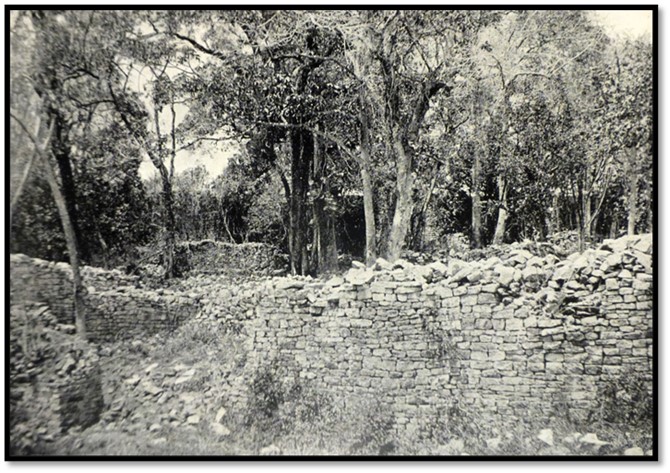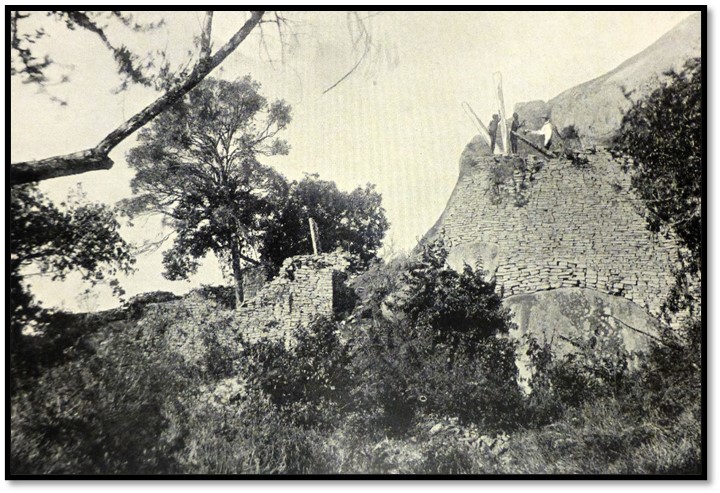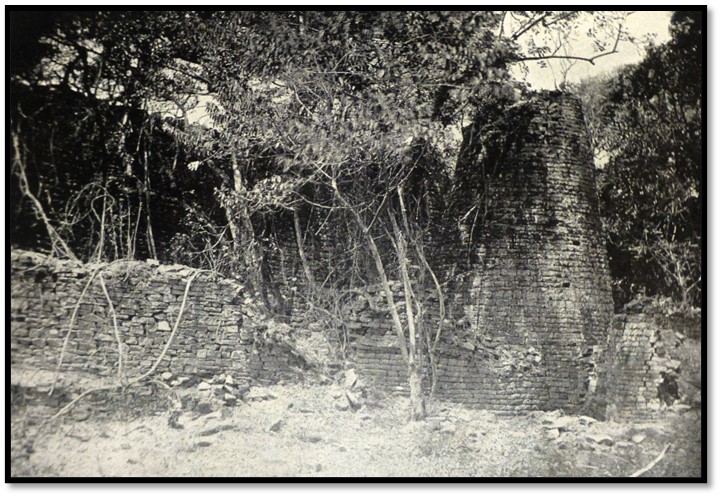The controversy in the early 20th Century over whether the stone structures in Zimbabwe were old and built by foreigners or comparatively recent and built by the Mashona
R.N. Hall’s thesis that both the stone structures and gold mines found throughout Rhodesia (now Zimbabwe) were ancient and directed by foreigners is laid out in his book The Ancient Ruins of Rhodesia (Monomotapae imperium) that he co-authored with W.G. Neal and published in 1904 that became the standard work on this subject.
In the following years 1905-6 Dr David Randall-MacIver carried out excavations at seven sites but concentrated on Great Zimbabwe and stated that the evidence from the sites was that they were built by Mashona people and comparatively recently. His conclusions were read in two papers at Bulawayo and the Royal Geographical Society, London and also in his book Mediaeval Rhodesia published in 1906 dating the ruins and gold mines to not before the 14th Century, a highly controversial view at the time that ran counter to popular opinion.
Hall replied to Dr Randall-MacIver’s conclusions in the 417 pages of Pre-Historic Rhodesia, published in 1909, concerning the origin and age of the Rhodesian gold mines and buildings that Randall-MacIver asserted were, "not earlier than some time in the eleventh century A.D.," and that the buildings were the work of "a negroid or negro race of African stock," and "characteristically African," and that the archaeological finds, except for the imported items were also "characteristically African" and "not more than a few centuries old."
How did the ancient and foreign origin thesis for Zimbabwe’s stone structures and gold mining come about?
Probably the connection began with the poet John Milton (1608-1674) in his epic poem Paradise Lost. Having gone blind in 1652, the poem is believed to have been dictated to his daughters and friends and in describing Adam’s vision of the earth it goes:
“…nor could his eye not ken
The empire of Negus to his utmost port
Ercoco, and the less maritime kings,
Mombaza, and Quiloa, and Melind,
And Sofala, thought Ophir, to the realm
Of Congo, and Angola farthest south…”[1]
By linking Sofala, on the Mozambique coast and the early entrepôt for gold from the Northern Mashonaland plateau with the port of Ophir where Hiram of Tyre brought gold for Solomon’s temple on Mount Moriah in Jerusalem, this ancient and foreign connection was forged.
Merensky and Karl Mauch expand the Ophir myth
Alexander Merensky, a German, worked for the Berlin Missionary Society and popularised the Sofala-Ophir legend of King Solomon’s mines through numerous newspaper articles in South Africa beginning in the 1860’s. The explorer Karl Mauch, the second visitor to Great Zimbabwe after Adam Renders, and also German, became a great friend of Merensky’s and was heavily influenced by him. In 1871 Mauch was taken to Great Zimbabwe by local natives after a gruelling journey and wrote, “The similarity of the aforementioned sacrifices to that of the Israelites is unmistakable. The basis is undoubtedly there even if much of the detail is left out. I do not think that I am far wrong if I suppose that the ruin on the hill is a copy of Solomon's Temple on Mount Moriah and the building in the plain a copy of the palace where the Queen of Sheba lived during her visit to Solomon.”[2]
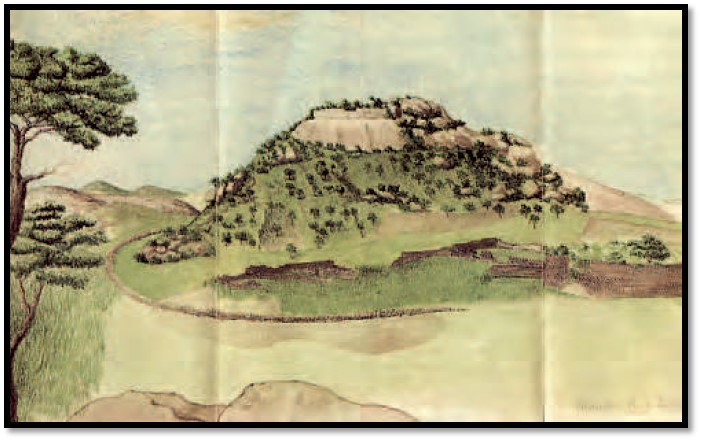
Karl Mauch: aquatint of the Acropolis (Hill Comples) from Mauch's diary sketches
Mauch’s work was much hampered by fighting between two factions in 1871-2 over ownership of Great Zimbabwe. One was led by Chief Mugabe and the other was made up of the Amangwa clan of the Karanga people and was still not resolved when Sir John Willoughby excavated in 1892.
Mauch quickly came to the conclusion that Great Zimbabwe was not the work of indigenous Africans. The stonework was too sophisticated, the culture too advanced and looked to have been built by Phoenicians or Israelites. Wood from a doorway lintel smelled like the cedar of his pencil; therefore, it must have come from Lebanon. The existence of the Sabi (Save) river 145 kms to the east and supposedly navigable to the coast as a means of trade and communication added to the mystery, and thus was the connection with the lost biblical city of Ophir perpetuated. Mauch did not believe that the buildings could have been built by the local people who inhabited the area at the time of his visit.[3]
Rider Haggard contributes to the myth
Rider Haggard was a great friend of Theodore Bent and added the following on his friend’s death in May 1897. “The world is full of ruins, but few of them have an origin so utterly lost in mystery as those of Zimbabwe in South Central Africa. Who built them? What purpose did they serve?… The labours and skilled observation of the late Mr. Theodore Bent, whose death is so great a loss to all interested in such matters, have shown almost beyond question that Zimbabwe was once an inland Phoenician city… But if actual proof is lacking, it is scarcely to be doubted… that it was the presence of payable gold reefs worked by slave labour which tempted the Phoenician merchants and chapmen, contrary to their custom, to travel so far from the sea and establish themselves inland. Perhaps the city Zimboe was the Ophir spoken of in the first Book of Kings…”
Cecil Rhodes also believes in the old and foreign origin
“If I am worn out please remember never abandon Mashonaland; it is the key to Central Africa, it is very healthy, full of gold and dominates the situation. You have got it and believe me keep it; it is worth more than all your other African possessions, it is simply full of gold reefs. As to alluvial I think the old Phœnicians worked that out. You will find that Zimbabye is an old Phoenician residence and everything points to Sofala being the place from which Hiram fetched his gold. The word ‘peacocks’ in the bible may be read as parrots and amongst the stone ornaments from Zimbabye are green parrots the common bird of that district, for the rest you have gold and ivory also the fact that Zimbabye is built of hewn stone without mortar… but I must not anticipate Bents [sic] discoveries he will be angry and start another theory in order to maintain originality.”
James Theodore Bent the archaeologist reinforces the ancient and foreign origins
Soon after the occupation of Mashonaland in 1890 all the intrigue around the origins of Great Zimbabwe and other structures led the British South Africa Company (BSAC) to ask the Royal Geographic Society (RGS) to send an experienced researcher to investigate and these two organisations, together with the British Association for the Advancement of Science, contributed funds and appointed Theodore Bent, a qualified archaeologist with his wife Mabel (née Hall-Dare) as photographer and illustrator, and Robert McNair Wilson Swan[4] who did the surveying and tried to date Great Zimbabwe through astronomical means.[5]
By early 1891 they were on-site and began by digging around the Conical Tower in the Great Enclosure - thereby completely destroying the stratigraphy and making it impossible for later archaeologists to make any sense of its age. Bent threw away clay and metal artifacts, including Persian and Arab trade beads, as insignificant, but fortunately after a fortnight’s digging moved on. By 1892 he had concluded that the builders of Great Zimbabwe were not indigenous Africans, but rather a civilization related to the Phoenicians and that they were drawn to the interior by the gold reefs and source of ivory. Like Mauch he believed Great Zimbabwe could not have been built by local Africans. This is rather a surprising conclusion since he later visited Mashona chiefs who lived in kraals surrounded by stone walls and are described in his book The Ruined Cities of Mashonaland: Being a Record of Excavation and Exploration in 1891 that was very popular at the time and ran to several editions.
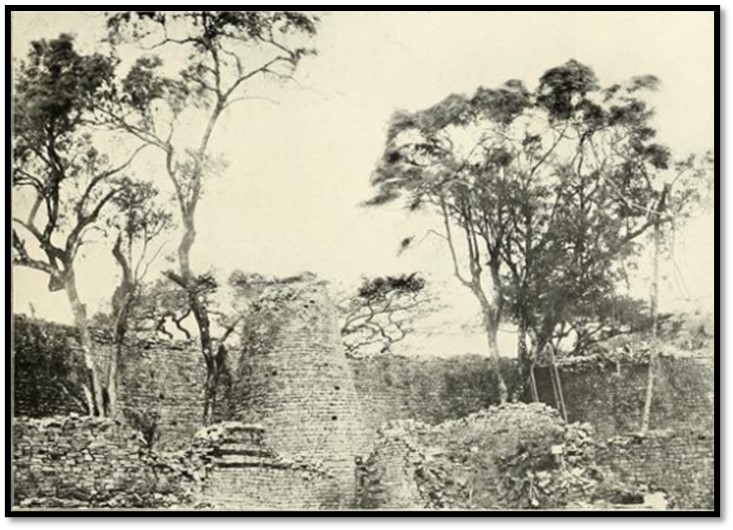
D. Randall-MacIver: The Conical Tower within the ‘Elliptical Temple’
Summers believes Bent was heavily influenced by Mauch’s writings.[6] He sent many locally manufactured items to the British Museum and these will feature in another article. The books’ reviewers, Professor D.A. Müller of Vienna and Mr W. St. Chad Boscawen of the British Museum agreed with Bent’s conclusions and so prolonged the ancient and foreign myth.
Sir John Willoughby
Roger Summers writes that Willoughby conducted what he considers the first scientific investigation in 1892 and published his findings the following year as A narrative of further excavations at Zimbabye (Mashonaland) However Willoughby was another enthusiastic amateur, not a trained archaeologist, but he does describe the deposits in which he dug and gives the depth of the objects found and they are all listed in an appendix in his report. However he totally dug out the soil wherever he excavated and left nothing for later archaeologists. Two small ruins near the present-day Museum were gutted to the extent they have now almost disappeared; the stones being used to build the grave for the thirty-three men of the Allan Wilson Patrol killed on 4 December 1893 north of the Shangani river.
In his favour he drew some accurate plans although no sections were drawn up. Willoughby criticised Swan’s astronomical theories but did not speculate on either the age or origin of Great Zimbabwe.
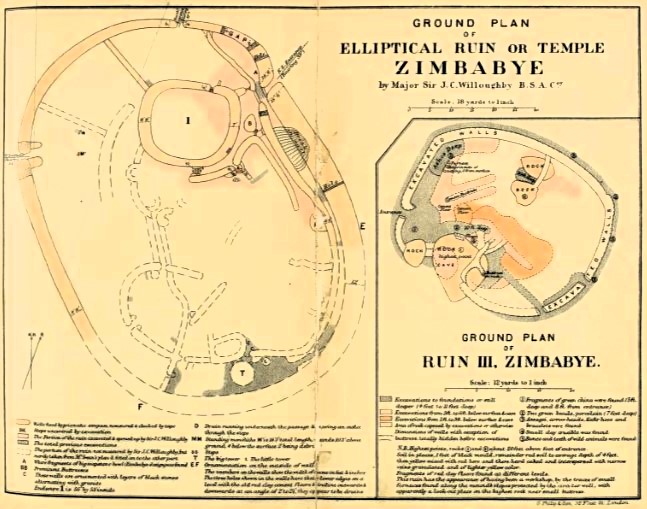
J.C. Willoughby: Plan of the Great Enclosure
Franklin White
Another non-Archaeologist, White was a mining engineer and his plan of the ‘Temple’ or ‘Elliptical building’ drawn in 1903 was used by all subsequent archaeologists until the Surveyor of Monuments, A. Whitty, drew a new plan in 1958.
White was careful and meticulous and he did not speculate on the age and origin of Great Zimbabwe, although Summers considers he viewed Great Zimbabwe as very old and probably accepted Hall’s views.
Photos from Franklin’s Notes on the Great Zimbabwe Elliptical Ruin are included below:
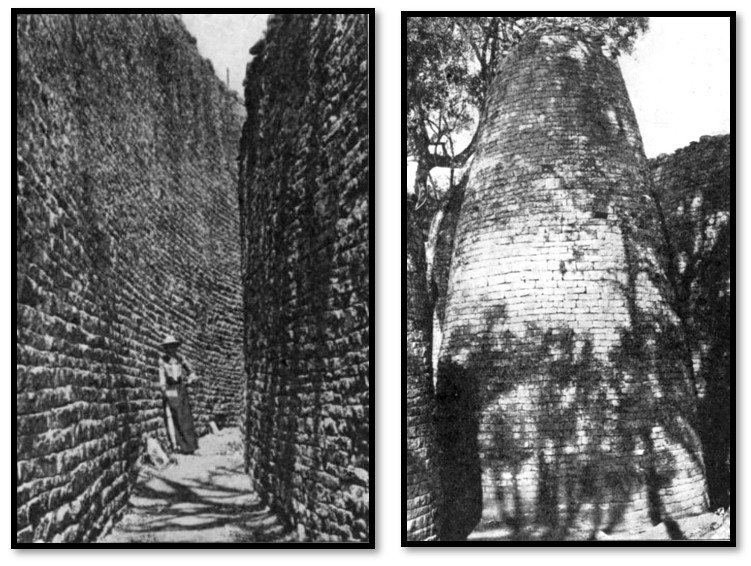
F. White: Parallel Passage F. White: Conical Tower
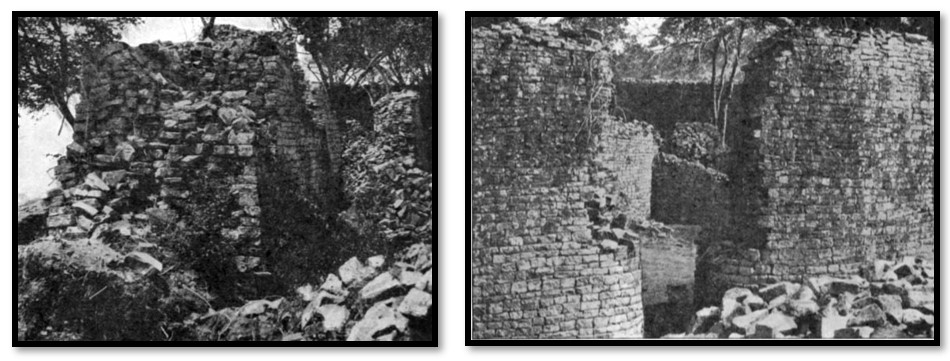
F. White: section of wall near main entrance F. White: North-West entrance
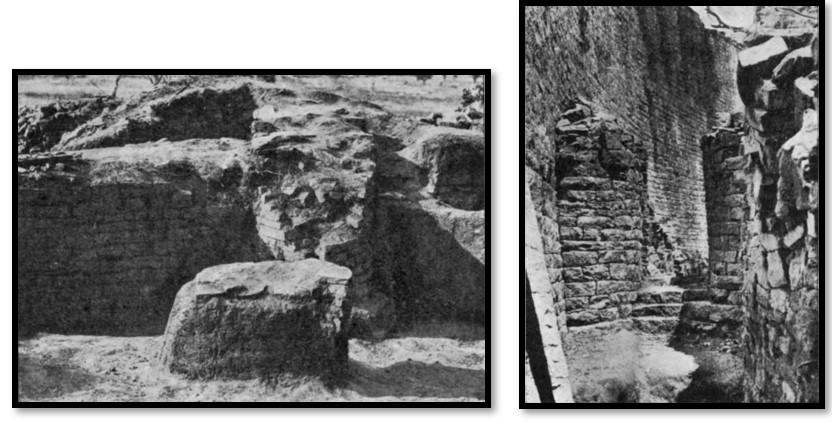
F. White: dhaka hut base, Valley ruins F. White: East doorway in Passage
Was Richard Nicklin Hall an archaeologist?
Hall had no formal training in archaeology and was formerly a solicitor before becoming an amateur archaeologist. He came to Rhodesia (now Zimbabwe) and was drawn into archaeological activities, but his excavations were criticized as amateurish, as was Sir John Willoughby’s, for lacking proper archaeological methodology and understanding. His work in 1901, particularly at Great Zimbabwe, was considered destructive, and his contract was eventually terminated due to the damage caused to the site. His co-author, W.G. Neal on The Ancient Ruins of Rhodesia (Monomotapae imperium) had built up his wide-ranging knowledge of ruins whilst pillaging many of the sites in Matabeleland and Midlands with the Ancient Ruins Company Ltd from 1895 to 1900, only Great Zimbabwe was exempted. Basically they were just treasure hunting for gold artefacts and threw away whatever was not valuable to them (i.e. the archaeological evidence in the form of pottery shards, pots, clay figurines)
The widespread criticism of the activities of both Hall and the Ancient Ruins Company Ltd led to the Legislative Council of Southern Rhodesia passing the Ancient Monuments Protection Ordinance of 1902 which protected ancient monuments and relics prior to 1800, but gold workings were not included and could be destroyed under the 1895 Mines and Minerals Ordinance.
Following the 1902 Ordinance, Richard Nicklin Hall (1852-1914) was appointed as curator of Great Zimbabwe and ‘excavated’ in 1902. It is believed his brief was to clear the ruins and make them accessible to tourists.[7] He not only cleared away all the trees and undergrowth but also “removed deposits to a depth of three to five feet throughout, on the excuse that they were merely the debris left by Rozvi and Karanga squatters who lived on the site long after their original builders had left.”[8] This process was described by a visiting archaeologist as “reckless blundering… worse than anything I have ever seen” and he was dismissed from his post.
In 1905 he published Great Zimbabwe which Summers writes is a useful resource in providing information about the state of Great Zimbabwe before Hall’s ‘restoration’ began and in it he named the various parts of the Valley ruins after early visitors.
Hall recognised that the huts that local people lived in were the same as those that he dug out and threw away and that the dhaka hut bases were also the same and that many of the excavated items were clearly of indigenous manufacture - soapstone dishes and phalli, iron tools and weapons, copper ornaments, indigenous pottery and gold ornaments – yet Hall also opted for an ancient and foreign origin for Great Zimbabwe!
R.N. Hall: walls within the Elliptical Temple (Great Enclosure)
R.N. Hall: Acropolis (Hill Complex) showing the monoliths
R.N. Hall: Conical Tower in the Elliptical Temple (Great Enclosure)
Roger Summers has some sympathy for Hall. In 1958 Summers[9] was conducting his own excavation at Great Zimbabwe and realised how useful Hall’s ramblings were when digging on the site of his predecessor’s trenches. Summers writes that Hall’s “observations – as distinct from his interpretations and conclusions – were unexpectedly reliable.”[10] Next year at Danamombe Summers confirmed the reliability of some of Hall’s observations, “hitherto hidden in a maze of obscure verbiage and unacceptable interpretation.”
1905 David Randall-MacIver,
Randall-MacIver who had studied under the famous William Matthew Flinders Petrie in Egypt, was appointed in 1905 by the British Association for the Advancement of Science to lead an expedition to Rhodesia (now Zimbabwe) and he excavated at Great Zimbabwe in June-July 1905.
He ignored all previous work and conclusions, used new dating methods accepting the various ruins may have been built at different periods and turned to the local indigenous people for cultural clues and interpretation rather than just for labouring on site. He had already visited the stone structures at Nyanga and Naletale and Danamombe and acquired local experience. He found a deep trench Hall had dug into a dhaka hut base that stopped short of the bedrock. MacIver found that below the dhaka was a mix of sand and ash containing spindle whorls, copper wire coils for bracelets and plain and decorated pottery. He wrote, “… exactly the same objects which were found in the top surface, 3.3 metres higher. The pottery from this lowest level is that which Mr Hall calls Makalanga (Karanga)[11] and which is, in fact, exactly like modern African pottery.”[12] His obvious conclusion as the uncovered artifacts were very similar to the ones being used by Shona, or Karanga, people living in the vicinity? “It is impossible, therefore, to resist the conclusion that the people who inhabited the ‘Elliptical Temple’ when it was built belonged to tribes whose arts and manufacturers were indistinguishable from those of the modern Makalanga.”[13]
Hall had dismissed these broken potsherds as worthless – he does not mention them and had Hall or any of the other investigators at the time drawn on the knowledge of the local people, many of the questions about Great Zimbabwe might well have been answered.
Randall-MacIver also established the Arab and Persian beads were no older than 14th or 15th century[14] and thus had no association with biblical times and King Solomon. Also he pointed out that the stonework was not at all Arabic, because it was curved and not arranged in geometric or symmetric patterns. Based on these observations in 1906 Randall-MacIver concluded in his book Mediaeval Rhodesia:
- Seven sites have been investigated,[15] and from not one of them has any object been obtained by myself, or by others before me, which can be shown to be more ancient than the fourteenth or fifteenth century.
- In the architecture, whether military or domestic, there is not a trace of Oriental or European style of any period whatever.
- Not a single [foreign] inscription has ever been found in the country.[16]
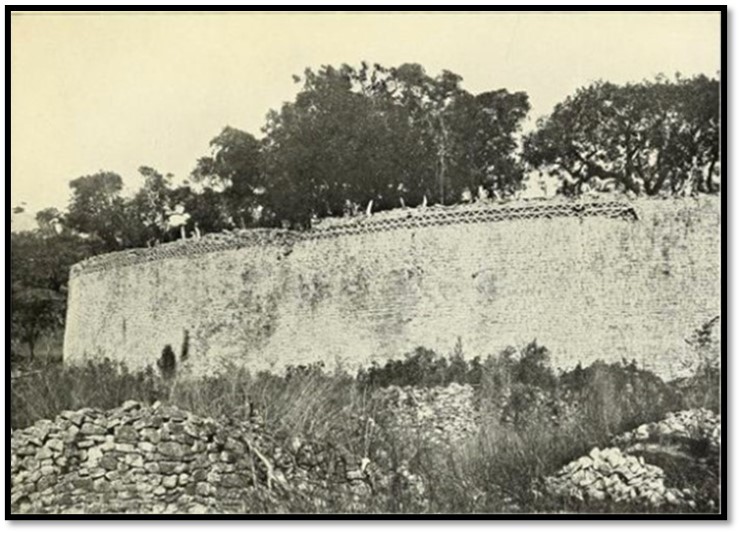
Randall-MacIver: façade of the Great Enclosure
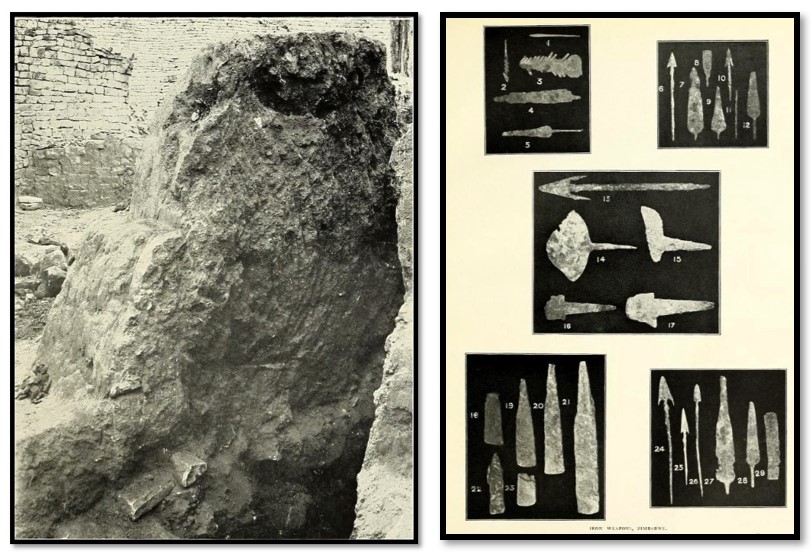
Randall-MacIver: section of excavated dhaka hut base Indigenous iron weapons
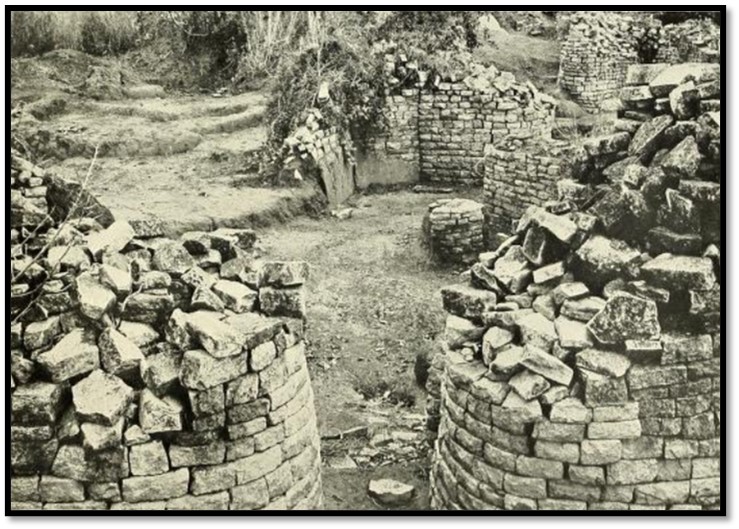
Randall-MacIver: excavated view of the Philips ruin in the Valley, Great Zimbabwe
Hall’s opening statements
Hall’s answer to Randall-MacIver’s Mediaeval Rhodesia was to publish Prehistoric Rhodesia in 1909, three years later. Hall is emphatic in his disagreement with Randall-MacIver that, “these are ruins belonging to some remote pre-historic times”…and “The same applies to the mines, which show varying degrees of culture, the oldest displaying the greatest skill in mining…” and “Therefore, I fail to discover anything in what Professor MacIver has written to shake those conclusions.”[17]
He continues, “Further, I have not attempted to follow Mr Bent in claiming the oldest building or rock mine as evidence of the presence of any ancient Arab colony in Rhodesia but have claimed the stone buildings as a resultant phase of an ancient intrusion of Asiatic influence, both Arabian and Western Indian, brought about by contact, covering centuries of time, in exploiting or trading for gold with some past occupiers of the country. This conclusion carries in its favour all expert mining opinion, and the support of all authorities on the Bantu.”
Hall also attempts to undermine Randall-McIver’s argument by stating his field survey is too limited to be valid saying that he examined “only seven ruins out of hundreds of all types” and “that his stay at any one ruin was far too short to admit of anything approaching an exhaustive examination.”
However, his argument remained essentially the same. The builders of the stone structures were foreign and probably from Southern Arabia encompassing eastern Yemen, parts of western Oman and southern Saudi Arabia where similar buildings existed and the Conical Tower was on Phoenician coins. Few archaeologists were convinced there was much new or were persuaded by Hall’s presentation.
The Zimbabwe origin controversy
At its heart the controversy was between Hall and others ancient and exotic origins versus local and comparatively recent. However Roger Summers also saw it as, “between antiquarianism, based on the library and the cabinet of curiosities and scientific archaeology, based on field studies and the laboratory; between the amateur and the professional; between the 19th century and the 20th.”[18]
Conclusions
In 1926 J.F. Schofield reiterated Randall-MacIver’s conclusions, and in 1929 Gertrude Caton-Thompson did the same. Her excavations of the undisturbed Maund Ruin which lies at the opposite end of the valley from the Great Enclosure again supported the theory of indigenous native construction.
They both confirmed Great Zimbabwe’s indigenous African origins. The archaeological studies, particularly those by David Randall-MacIver and Gertrude Caton-Thompson, provided evidence that:
- Great Zimbabwe and all the other stone structures were constructed by the ancestors of the Mashona people, an indigenous African group. These studies demonstrated that the construction techniques and materials used were consistent with local traditions and not the product of foreign influences.
- The results of their excavations did not support Bent’s theories of historical and cultural links with the Phoenicians, that were maritime traders who established coastal settlements and there was no historical record of their presence in the interior of Africa where Great Zimbabwe is located.
- Starting with Mauch and continuing with Bent their interpretation of artifacts and architectural features was speculative and did not consider indigenous natives capable of erecting the stone structures scattered throughout present-day Zimbabwe or their skill in mining quartz reefs for gold. Randall-MacIver, Schofield and Caton-Thompson showed that the artifacts found at Great Zimbabwe were consistent with local African cultures.
The controversy between Hall’s old and foreign origins and those of Randall-MacIver’s comparatively recent and built by Mashona was unfortunate as it very much obscured the issues and confused the public. It was fuelled by the clash of personalities between a learned amateur and a trained archaeologist and confused the origin of Great Zimbabwe and all the other stone structures in present-day Zimbabwe for far too long.
References
J.T. Bent. The Ruined Cities of Mashonaland: Being a Record of Excavation and Exploration in 1891. Longmans, Green and Co, London 1892
R.N. Hall and W.G. Neal. The Ancient Ruins of Rhodesia (Monomotapae imperium) Methuen and Co, London, 1904. Internet archive https://archive.org/details/ancientruinsrho01nealgoog
R.N. Hall. Great Zimbabwe, Mashonaland, Rhodesia: An Account of Two Years' Examination Work in 1902-4 on Behalf of the Government of Rhodesia
R.N. Hall. Prehistoric Rhodesia: an examination of the historical, ethnological and archaeological evidences as to the origin and ag e of the rock mines and stone buildings, with a gazetteer of mediaeval south-east Africa, 915 A.D. to 1760 A.D., and the countries of the Monomotapa, Manica, Sabia, Quiteve, Sofala and Mozambique. Fisher Unwin, London 1909
D. Randall-MacIver. Mediaeval Rhodesia. Macmillan and Co, London 1906
R. Summers. Zimbabwe, A Rhodesian Mystery. Thomas Nelson and Sons (Africa) (Pty) Ltd, 1965
F. White. Notes on the Great Zimbabwe Elliptical Ruin. The Journal of the Anthropological Institute of Great Britain and Ireland. Vol 35 (Jan-June 1905) P39-47
J.C. Willoughby. A narrative of further excavations at Zimbabye (Mashonaland) G. Philip & Son, London, 1893
https://library.si.edu/digital-library/book/narrativeoffurth00will
[1] Paradise Lost, XI, P396-401
[2] Zimbabwe, A Rhodesian Mystery, P19
[3] See the article Karl Mauch, explorer and geologist and the man who claimed to be the first European to visit Great Zimbabwe under Masvingo Province on the website www.zimfieldguide.com
[4] Robert McNair Wilson Swan (1858-1904) was a Glaswegian surveyor who the Bents had met in the Greek islands and contributed. Swan’s sketch plan of great Zimbabwe was the first reasonably accurate representation of the site. However he was convinced there was an astronomical basis for the Great Enclosure and spent much time and energy on this subject
[5] In 1901 the Astronomer Royal had dated Stonehenge through a method known as the procession of the equinoxes whereby the very slow wobble of the earth’s axis results in the position of the sun on Midsummer’s Day being predictable 5,000 years ago. However this only works when the original builders accurately aligned their site with the sun on Midsummer’s day and had good astronomical knowledge. F.P. Mennel, a well-known local
[6] Zimbabwe, A Rhodesian Mystery, P23
[7] The BSAC records were all destroyed in the London blitz in 1941
[8] Zimbabwe, A Rhodesian Mystery, P26
[9] Roger Summers was a trained archaeologist and was Chairman of the Southern Rhodesia Historical Monuments Commission from 1954-9 and later President of the South African Archaeological Society
[10] Zimbabwe, A Rhodesian Mystery, P26
[11] People living immediately around Great Zimbabwe are mostly Kalanga, but include Ndau (another Shona sub-group) and Zezuru
[12] Pre-Historic Rhodesia, P34
[13] Mediaeval Rhodesia, P63
[14] Ibid, P63
[15] The seven sites were Inyanga (Nyanga) Van Niekerk ruins, Umtali, Dhlo-Dhlo (Danamombe) Nanatale (Naletale) Khami (Khame) and Great Zimbabwe
[16] Ibid, P83
[17] Pre-Historic Rhodesia, P2
[18] Zimbabwe, A Rhodesian Mystery, P37

